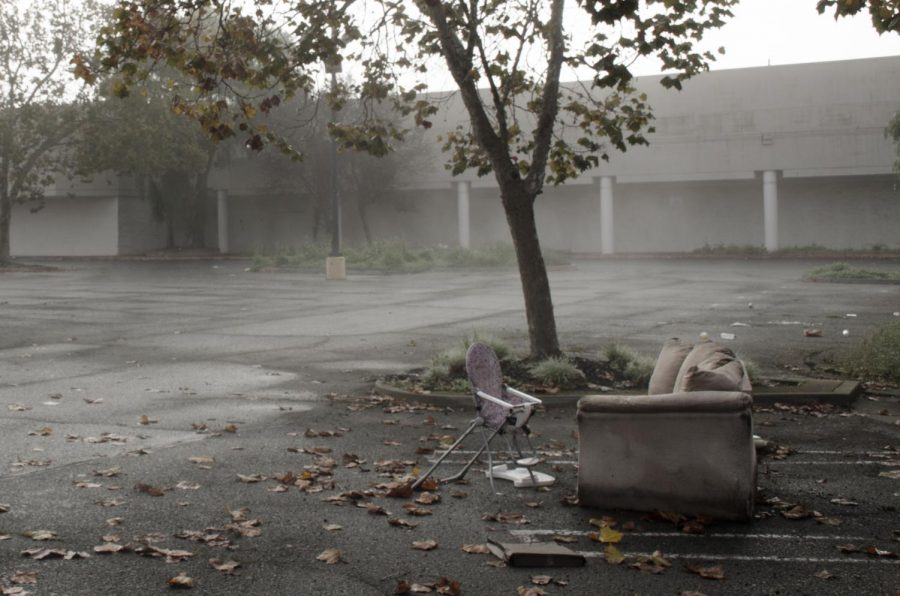Suburban gothic: the life and death of shopping malls
November 16, 2017
“I am often called the father of the shopping mall. I would like to take this opportunity to disclaim paternity once and for all. I refuse to pay alimony to those bastard developments. They destroyed our cities,” said Victor Gruen shortly before his death in 1978.
Gruen designed the first mall, built in Edina, Minnesota in 1956. He initially thought of the modern shopping center as a space which provided suburbs with “the needed place and opportunity for participation in modern community life that the ancient Greek Agora, the medieval market place and our own town squares provided in the past.”
He envisioned it as the answer to suburban nebulousness: a dense mix of commerce, community resources, entertainment and even housing in an otherwise civic black hole. Here, suburbanites could spend their free time ambling around, the soft sounds of muzak lilting in the air. After seeing a show or running an errand, they could leisurely make their way to the food court to gather for a meal.
But Gruen considered the outcome to be more Frankenstein than brainchild, as malls didn’t become the mini city-centers he had imagined.
Diablo Valley College architecture professor Chi Zhu said that, “Unfortunately, the forward thinking social idea was later replaced with the pure economic incentives of harvesting both the handsome amount of real estate profit for reselling the malls and the advantageous federal tax incentives.” By the late 1950s, developers were buying up cheap land on the outskirts of town, putting in a mall, selling them for large profits, then going off to build another.
“All over the United States, shopping plazas sprouted like well-fertilized weeds,” wrote urban historian Thomas Hanchett. According to Cowen & Co’s research analysts, by 2015 there was 23.5 square feet of retail space per person in the U.S. This proliferation wreaked havoc on mom and pop businesses and even encouraged the thing Gruen hated most: sprawl.
Nowhere is this more evident than in the area around DVC. Within spitting distance of campus, there are five separate shopping plazas, offering what seem to be iterations of the same thing. But much like the rundown, perennially vacant DVC Plaza, malls and shopping centers nationwide have begun to falter. Some 3,500 stores have shuttered this year, and they are taking close to 500,000 jobs with them.
According to a report put out by Morningstar Analysts, the Macy’s in Concord’s Sunvalley Mall is at risk of closure as a result of retail losses. And while this doesn’t necessarily constitute mutually assured destruction, when a large anchor store like Macy’s vacates the premises, the smaller stores around it tend to follow suit.
What’s left behind is usually not pretty. These large spaces are designed for big box or department stores and are expensive to lease. As chains like Sears and J.C. Penny’s dramatically scale back their number of brick and mortar locations, they have become challenging to fill. So they often sit vacant, leaving behind a wake of suburban blight and crime.
Again, look no further than DVC Plaza. When K-mart left the premises, the rest slowly went to ruin. What was once a bastion for gaggles of bored teenagers, known colloquially as mallrats, is now a haven for actual rats.
So why have so many malls and shopping centers fallen out of favor?
Growth in online retail is the obvious culprit. Consumer Intelligence research found that 46 percent of households in the U.S. have an Amazon Prime account. Prime’s ease of use and free shipping and returns might explain why Amazon’s clothing and accessory sales are expected to grow nearly 30 percent next year, reaching $28 billion according to Cowen & Co.
But a desire for more authentic, community-oriented experiences also seems to be at play and it’s changing the way Americans spend their time and money. While retail is struggling, the restaurant and travel industries are thriving. According to Business Insider, people in the U.S. now spend as much money eating out, mostly at small, local eateries, as they do on groceries. Similarly, the World Travel & Tourism Council notes that money spent while traveling grew 4.5 percent in 2017, with Southeast Asia listed as the most popular destination.
So, if shopping centers seemed to be doomed, you may wonder why Concord is building yet another one. The Veranda, a new shopping plaza, is underway just across the freeway from DVC. Enter the “Lifestyle Center,” a new breed of shopping center popping up in response to the changing tastes of consumers.
When asked what lifestyle centers provide that protects them from this sea change, Ashton Simmons the general manager of the Veranda, boils it down to what he calls placemaking, which he writes “challenges the more traditional shopping centers by creating community spaces with plazas, fountains, music and landscaping, forming the essential backdrop for not only retail stores, but also integrating entertainment, luxury cinemas, a unique grocery store, carefully chosen restaurants, fitness, office and other activities. This makes this center a gathering place for the community; in a sense, a new living room for residents to claim as their own.”

This is, in theory, much closer to Gruen’s original vision. It paints a picture of a place with all the trappings of the thriving downtowns of yore that Americans seem to be craving.
But in the 1958 article entitled “Downtown is for people,” urban planning activist Jane Jacobs wrote, “Notice that when a new building goes up, the kind of ground-floor tenants it gets are usually the chain store and the chain restaurant. Lack of variety in age and overhead is an unavoidable defect in large new shopping centers and is one reason why even the most successful cannot incubate the unusual.”
So far, all the confirmed tenants of the Veranda are chains, albeit ones dressed up as something more local and authentic. It all just sort of feels like being served a hot pocket when you ordered an empanada.
Time will tell if this new brand of retail experience has staying power. But regardless, the buildings live on and the good news is that slowly, they are starting to see new life.
DVC professor of architecture, Daniel Abbott, explains, “If the economic need is there, it will often drive change in a very short period of time and generally with good quality work. So the idea that things can physically change in these shopping centers should the economy change is possible in the years to come.”
The DVC Plaza is slated to become a Carmax. And should the retail apocalypse come to fruition, the Willows could be a new wing of the DVC campus, the Sunvalley Mall, a highway megachurch. The possibilities are endless.









































































